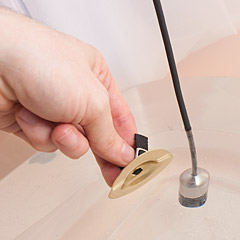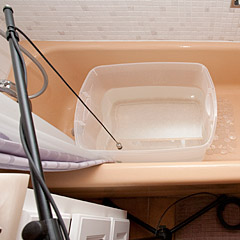Underwater Finger Cymbals
Posted: March 2nd, 2010 | Author: Nathan | Filed under: found sound objects, sound design
Dipping struck finger cymbals into water creates some great filtering effects.
[Credit where credit’s due: This is a technique I’ve always wanted to try, and I first heard of it in a great video by Roger Gregg, at around 02:45. The entire series is worth watching.]
So a fellow gets a hydrophone. He’s excited, and starts recording all sorts of crap. But then he has a free hour to himself and realizes that he’s got a box full of sound-making toys and objects that could sound pretty interesting underwater.
Let’s say I’m that fellow.
Before work one day, I sifted through said toybox and decided to give this a whirl. In search for a large container to fill with water, I decided to record in the executive washroom of Noise Jockey World Headquarters, and the photos in this post will give you a glimpse of the sumptuous luxury in which we conduct our noisy business.
Since our high-tech executive spa didn’t have a stopper handy, I grabbed a plastic tub and filled it with lukewarm water. I put the hydrophone halfway between the surface of the water and the bottom of the tub, suspended from a boom arm so the cable would be isolated from noise and the mic element wouldn’t sit on the bottom.
-

An Aquarian H2-XLR hydrophone set into a tub of water.
The Aquarian H2a-XLR hydrophone is pretty heavy and holds quite still. One gotcha is that a high-frequency hiss can occur from air bubbles forming on the microphone casing. This can be a challenge if the water coming out of your spigot is highly aerated. I’m still working on solving that one.
I donned a pair of finger cymbals (truly something every sound recordist should own!) and dipped one or both of them in the water after striking them together. They went into the water at a 60°-90° angle, so that they’d not create entry splashes or secondary water drips. This created a really neat tone that combined a pitch bend with a very resonant filter cutoff.
I’ve attached an edit of the raw recordings to this post. Pitch-bent down or up, obviously, there’s a lot of sonic possibilities for sound design. As with all such experiments I do, I tracked at 192kHz to ensure enough latitude for further sonic malfeasance.
[soundcloud url=”http://soundcloud.com/noisejockey/finger-cymbals-in-water” params=”show_comments=true&auto_play=false&color=dd0000″ width=”100%” height=”81″ ]
[Aquarian H2a-XLR hydrophone into Sound Devices 702 recorder]
This is great. You’ve got to put other objects in the water. You have an electric toothbrush? Ooooooh, wait, maybe I should do that!
Hah, just you wait. More subaquatic shenanigans to come. But yeah, Michael, get yer Dolphin Ear on and share! :-)
I’ve got to clean my tub first!
Great sound!
Very cool. I’ve always liked the way water bends the pitch of metal (many a dishwashing session has gone on too long as I rediscover this while washing metal pots!). Have you considered also miking the cymbals above water and mixing the sounds? Imagine mixing this in surround, with the above-water sound in front and the underwater in the rear channels. Sort of a simulated doppler effect.
Good sound! I haven’t tried it but according to DPA, washing up liquid on the hydrophone solves the air bubbles problem…